Indoor and Outdoor Activities: Exploring Sustainable Practices in ECE
VerifiedAdded on 2023/05/31
|18
|3770
|303
Homework Assignment
AI Summary
This assignment delves into various aspects of early childhood education, focusing on indoor and outdoor activities. It explores the promotion of risk and adventure through activities like climbing trees and building forts, and also discusses educating parents about the benefits of risky play. The assignment references a Sun Smart policy, detailing measures for sun protection. Furthermore, it covers strategies for ensuring appropriate educator-to-child ratios and maintaining those ratios through various methods. The assignment also examines provocations and creativity within the context of a natural playscape project, including the Early Years Learning Framework's learning outcomes. It then outlines sustainable purchasing strategies, incorporating children in sustainable practices, and promoting sustainability to families. Finally, the assignment requires research on local sustainable purchasing options for various materials, including play materials, cleaning products, and food items, analyzing their impact on the carbon footprint.
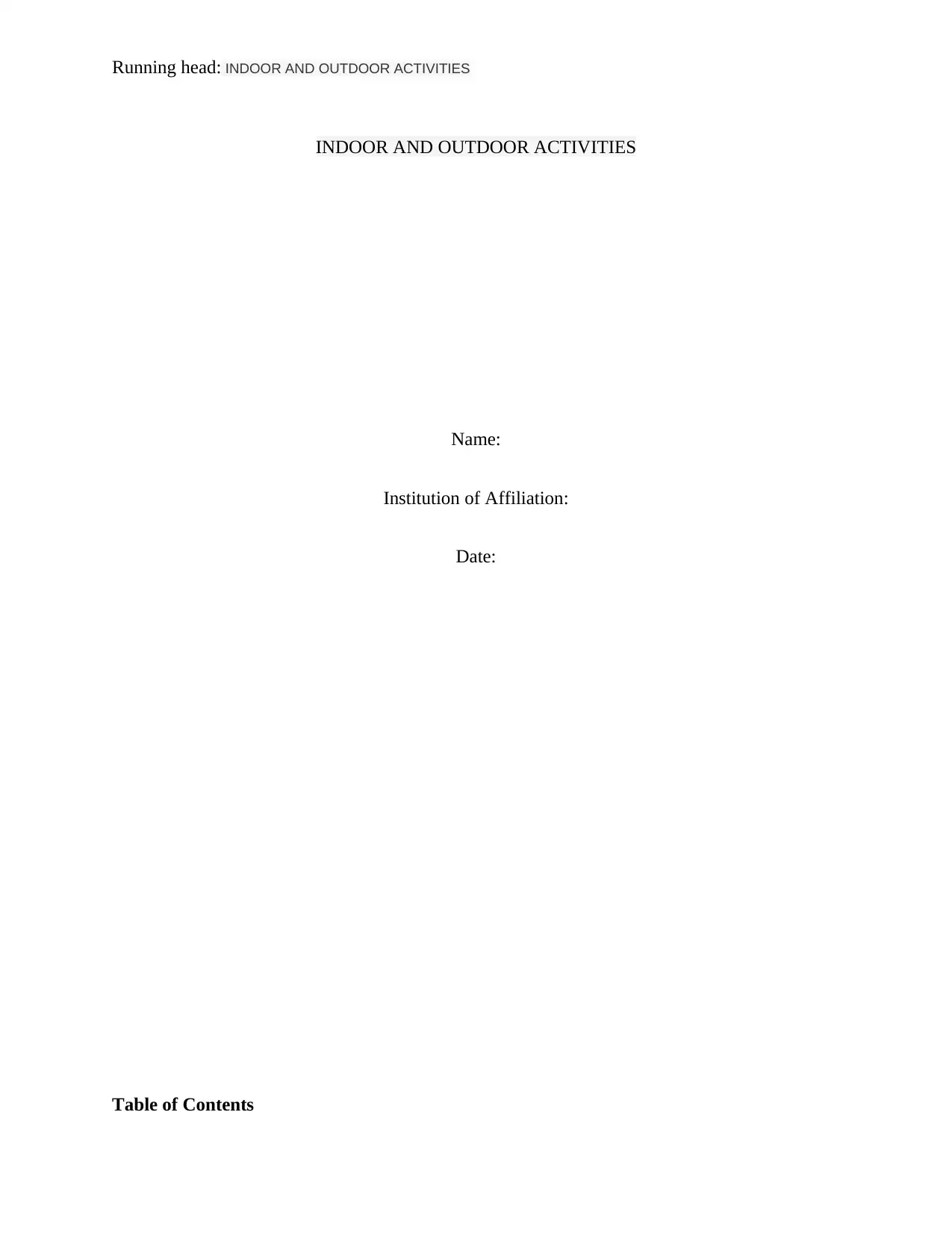
Running head: INDOOR AND OUTDOOR ACTIVITIES
INDOOR AND OUTDOOR ACTIVITIES
Name:
Institution of Affiliation:
Date:
Table of Contents
INDOOR AND OUTDOOR ACTIVITIES
Name:
Institution of Affiliation:
Date:
Table of Contents
Paraphrase This Document
Need a fresh take? Get an instant paraphrase of this document with our AI Paraphraser
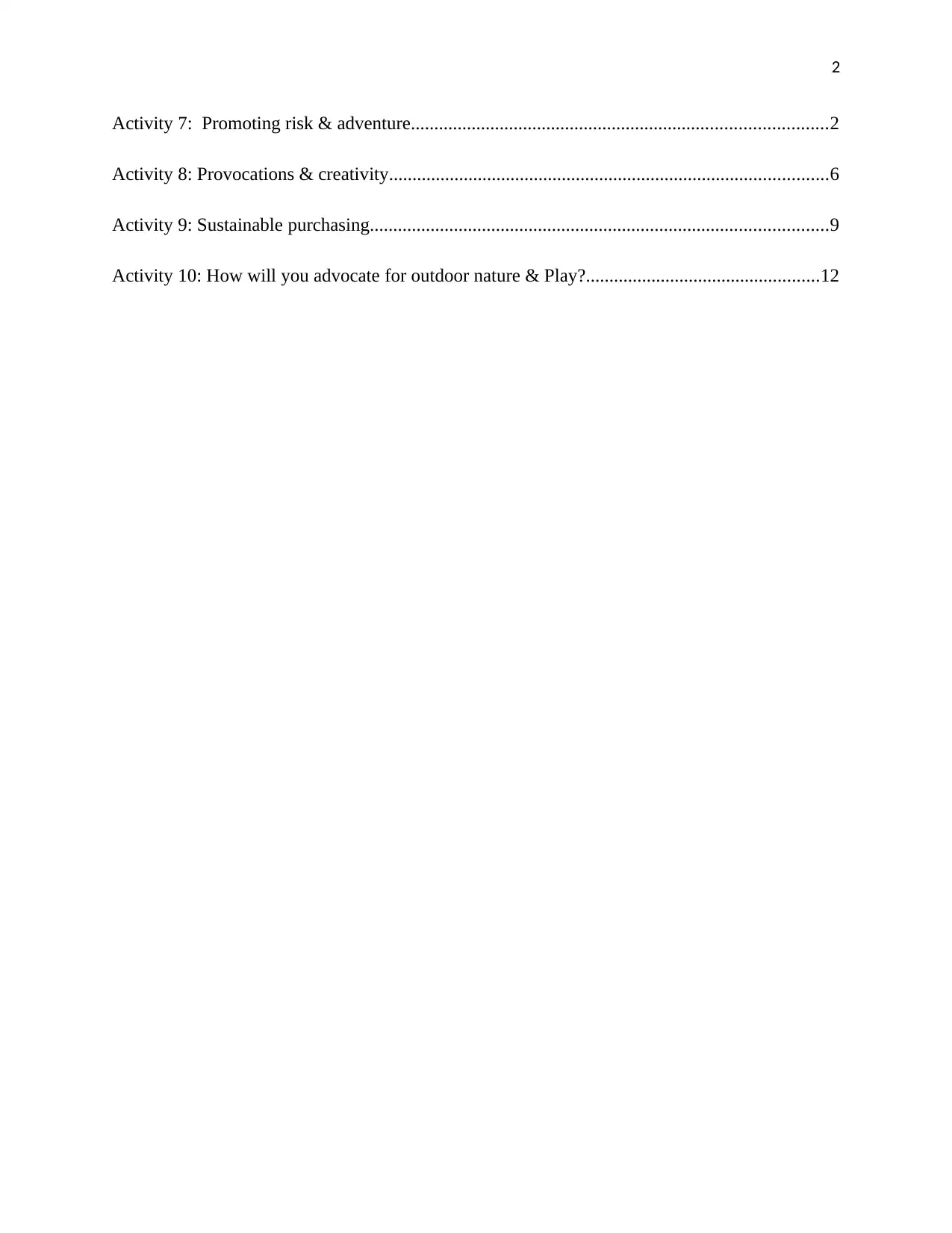
2
Activity 7: Promoting risk & adventure.........................................................................................2
Activity 8: Provocations & creativity..............................................................................................6
Activity 9: Sustainable purchasing..................................................................................................9
Activity 10: How will you advocate for outdoor nature & Play?..................................................12
Activity 7: Promoting risk & adventure.........................................................................................2
Activity 8: Provocations & creativity..............................................................................................6
Activity 9: Sustainable purchasing..................................................................................................9
Activity 10: How will you advocate for outdoor nature & Play?..................................................12
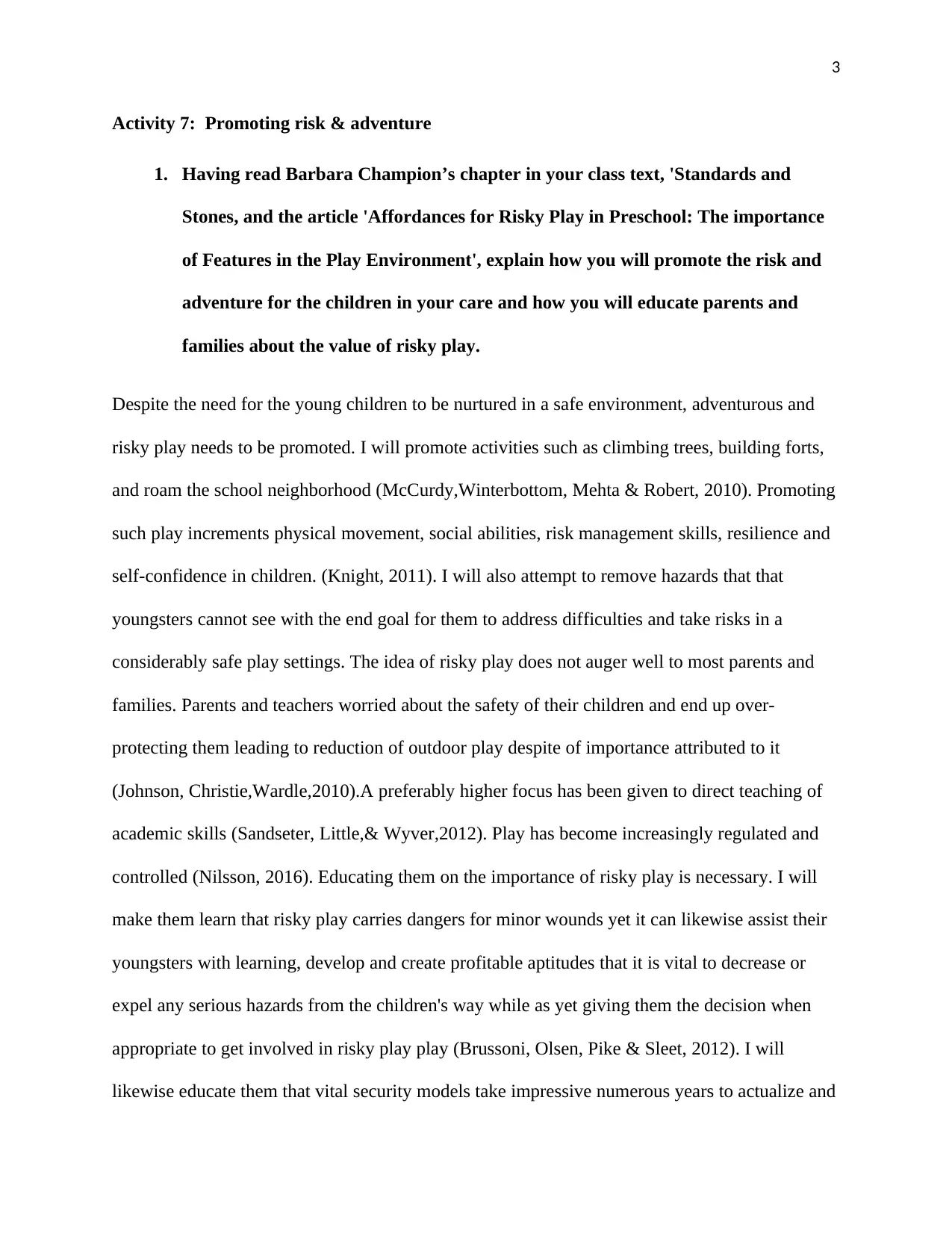
3
Activity 7: Promoting risk & adventure
1. Having read Barbara Champion’s chapter in your class text, 'Standards and
Stones, and the article 'Affordances for Risky Play in Preschool: The importance
of Features in the Play Environment', explain how you will promote the risk and
adventure for the children in your care and how you will educate parents and
families about the value of risky play.
Despite the need for the young children to be nurtured in a safe environment, adventurous and
risky play needs to be promoted. I will promote activities such as climbing trees, building forts,
and roam the school neighborhood (McCurdy,Winterbottom, Mehta & Robert, 2010). Promoting
such play increments physical movement, social abilities, risk management skills, resilience and
self-confidence in children. (Knight, 2011). I will also attempt to remove hazards that that
youngsters cannot see with the end goal for them to address difficulties and take risks in a
considerably safe play settings. The idea of risky play does not auger well to most parents and
families. Parents and teachers worried about the safety of their children and end up over-
protecting them leading to reduction of outdoor play despite of importance attributed to it
(Johnson, Christie,Wardle,2010).A preferably higher focus has been given to direct teaching of
academic skills (Sandseter, Little,& Wyver,2012). Play has become increasingly regulated and
controlled (Nilsson, 2016). Educating them on the importance of risky play is necessary. I will
make them learn that risky play carries dangers for minor wounds yet it can likewise assist their
youngsters with learning, develop and create profitable aptitudes that it is vital to decrease or
expel any serious hazards from the children's way while as yet giving them the decision when
appropriate to get involved in risky play play (Brussoni, Olsen, Pike & Sleet, 2012). I will
likewise educate them that vital security models take impressive numerous years to actualize and
Activity 7: Promoting risk & adventure
1. Having read Barbara Champion’s chapter in your class text, 'Standards and
Stones, and the article 'Affordances for Risky Play in Preschool: The importance
of Features in the Play Environment', explain how you will promote the risk and
adventure for the children in your care and how you will educate parents and
families about the value of risky play.
Despite the need for the young children to be nurtured in a safe environment, adventurous and
risky play needs to be promoted. I will promote activities such as climbing trees, building forts,
and roam the school neighborhood (McCurdy,Winterbottom, Mehta & Robert, 2010). Promoting
such play increments physical movement, social abilities, risk management skills, resilience and
self-confidence in children. (Knight, 2011). I will also attempt to remove hazards that that
youngsters cannot see with the end goal for them to address difficulties and take risks in a
considerably safe play settings. The idea of risky play does not auger well to most parents and
families. Parents and teachers worried about the safety of their children and end up over-
protecting them leading to reduction of outdoor play despite of importance attributed to it
(Johnson, Christie,Wardle,2010).A preferably higher focus has been given to direct teaching of
academic skills (Sandseter, Little,& Wyver,2012). Play has become increasingly regulated and
controlled (Nilsson, 2016). Educating them on the importance of risky play is necessary. I will
make them learn that risky play carries dangers for minor wounds yet it can likewise assist their
youngsters with learning, develop and create profitable aptitudes that it is vital to decrease or
expel any serious hazards from the children's way while as yet giving them the decision when
appropriate to get involved in risky play play (Brussoni, Olsen, Pike & Sleet, 2012). I will
likewise educate them that vital security models take impressive numerous years to actualize and
⊘ This is a preview!⊘
Do you want full access?
Subscribe today to unlock all pages.

Trusted by 1+ million students worldwide
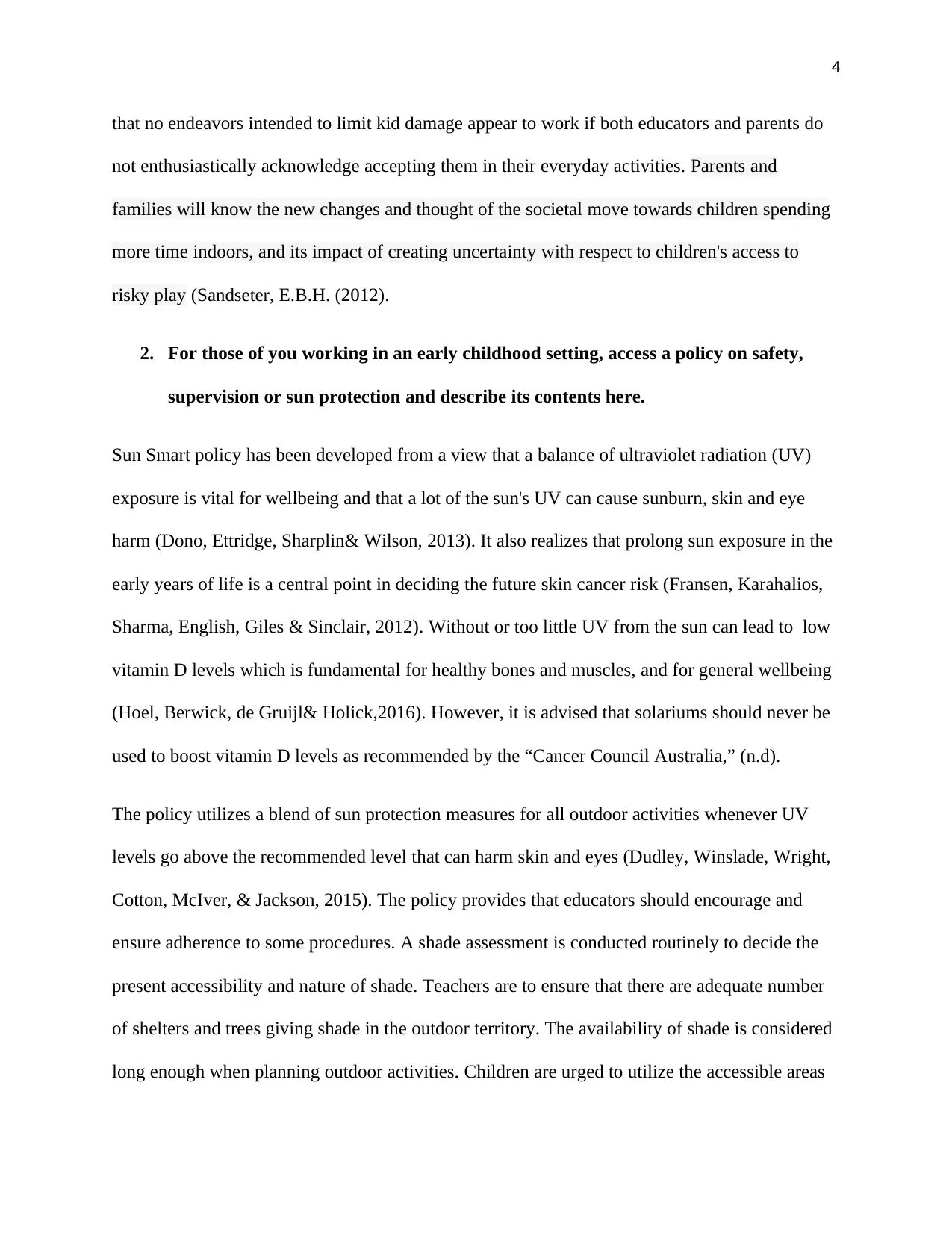
4
that no endeavors intended to limit kid damage appear to work if both educators and parents do
not enthusiastically acknowledge accepting them in their everyday activities. Parents and
families will know the new changes and thought of the societal move towards children spending
more time indoors, and its impact of creating uncertainty with respect to children's access to
risky play (Sandseter, E.B.H. (2012).
2. For those of you working in an early childhood setting, access a policy on safety,
supervision or sun protection and describe its contents here.
Sun Smart policy has been developed from a view that a balance of ultraviolet radiation (UV)
exposure is vital for wellbeing and that a lot of the sun's UV can cause sunburn, skin and eye
harm (Dono, Ettridge, Sharplin& Wilson, 2013). It also realizes that prolong sun exposure in the
early years of life is a central point in deciding the future skin cancer risk (Fransen, Karahalios,
Sharma, English, Giles & Sinclair, 2012). Without or too little UV from the sun can lead to low
vitamin D levels which is fundamental for healthy bones and muscles, and for general wellbeing
(Hoel, Berwick, de Gruijl& Holick,2016). However, it is advised that solariums should never be
used to boost vitamin D levels as recommended by the “Cancer Council Australia,” (n.d).
The policy utilizes a blend of sun protection measures for all outdoor activities whenever UV
levels go above the recommended level that can harm skin and eyes (Dudley, Winslade, Wright,
Cotton, McIver, & Jackson, 2015). The policy provides that educators should encourage and
ensure adherence to some procedures. A shade assessment is conducted routinely to decide the
present accessibility and nature of shade. Teachers are to ensure that there are adequate number
of shelters and trees giving shade in the outdoor territory. The availability of shade is considered
long enough when planning outdoor activities. Children are urged to utilize the accessible areas
that no endeavors intended to limit kid damage appear to work if both educators and parents do
not enthusiastically acknowledge accepting them in their everyday activities. Parents and
families will know the new changes and thought of the societal move towards children spending
more time indoors, and its impact of creating uncertainty with respect to children's access to
risky play (Sandseter, E.B.H. (2012).
2. For those of you working in an early childhood setting, access a policy on safety,
supervision or sun protection and describe its contents here.
Sun Smart policy has been developed from a view that a balance of ultraviolet radiation (UV)
exposure is vital for wellbeing and that a lot of the sun's UV can cause sunburn, skin and eye
harm (Dono, Ettridge, Sharplin& Wilson, 2013). It also realizes that prolong sun exposure in the
early years of life is a central point in deciding the future skin cancer risk (Fransen, Karahalios,
Sharma, English, Giles & Sinclair, 2012). Without or too little UV from the sun can lead to low
vitamin D levels which is fundamental for healthy bones and muscles, and for general wellbeing
(Hoel, Berwick, de Gruijl& Holick,2016). However, it is advised that solariums should never be
used to boost vitamin D levels as recommended by the “Cancer Council Australia,” (n.d).
The policy utilizes a blend of sun protection measures for all outdoor activities whenever UV
levels go above the recommended level that can harm skin and eyes (Dudley, Winslade, Wright,
Cotton, McIver, & Jackson, 2015). The policy provides that educators should encourage and
ensure adherence to some procedures. A shade assessment is conducted routinely to decide the
present accessibility and nature of shade. Teachers are to ensure that there are adequate number
of shelters and trees giving shade in the outdoor territory. The availability of shade is considered
long enough when planning outdoor activities. Children are urged to utilize the accessible areas
Paraphrase This Document
Need a fresh take? Get an instant paraphrase of this document with our AI Paraphraser
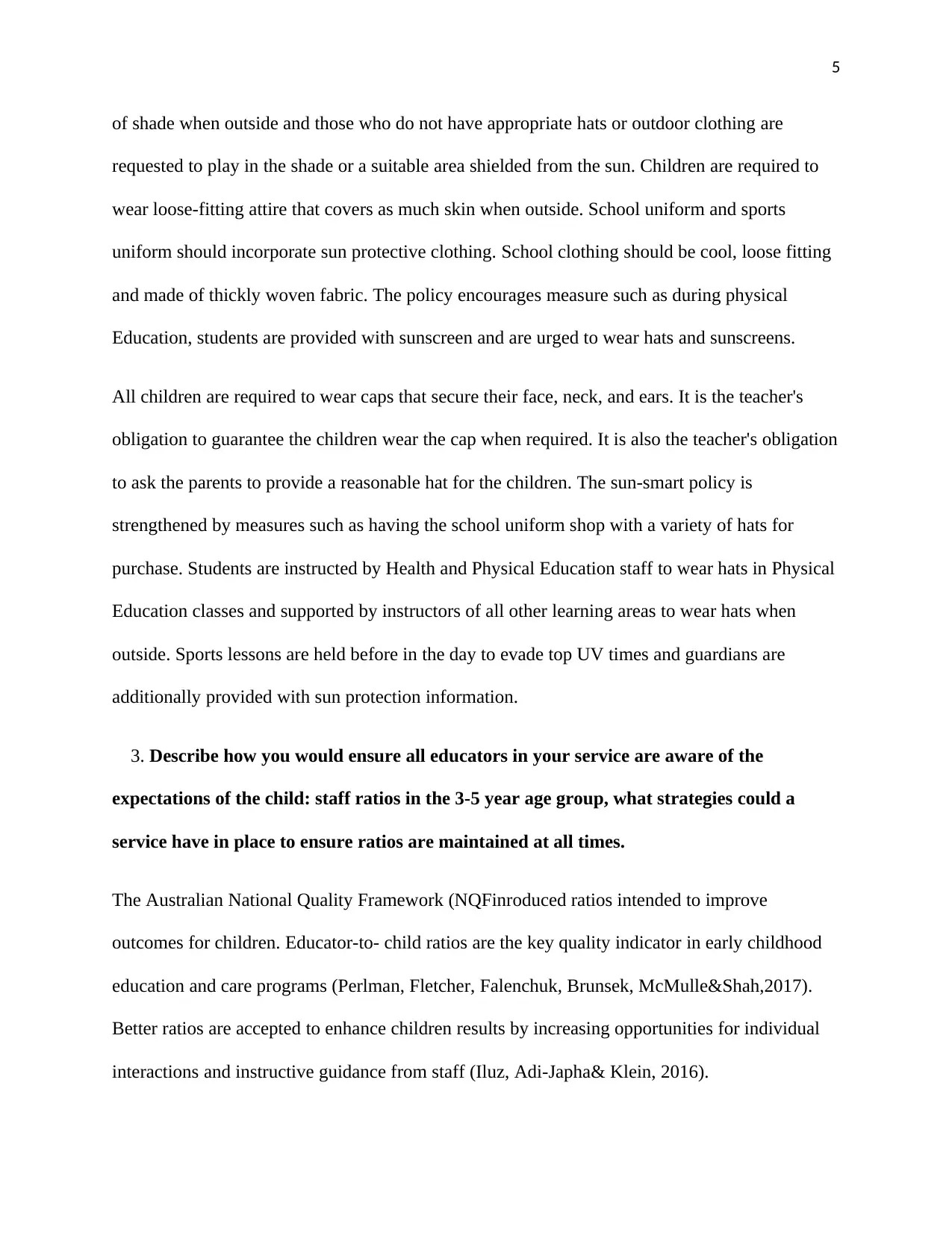
5
of shade when outside and those who do not have appropriate hats or outdoor clothing are
requested to play in the shade or a suitable area shielded from the sun. Children are required to
wear loose-fitting attire that covers as much skin when outside. School uniform and sports
uniform should incorporate sun protective clothing. School clothing should be cool, loose fitting
and made of thickly woven fabric. The policy encourages measure such as during physical
Education, students are provided with sunscreen and are urged to wear hats and sunscreens.
All children are required to wear caps that secure their face, neck, and ears. It is the teacher's
obligation to guarantee the children wear the cap when required. It is also the teacher's obligation
to ask the parents to provide a reasonable hat for the children. The sun-smart policy is
strengthened by measures such as having the school uniform shop with a variety of hats for
purchase. Students are instructed by Health and Physical Education staff to wear hats in Physical
Education classes and supported by instructors of all other learning areas to wear hats when
outside. Sports lessons are held before in the day to evade top UV times and guardians are
additionally provided with sun protection information.
3. Describe how you would ensure all educators in your service are aware of the
expectations of the child: staff ratios in the 3-5 year age group, what strategies could a
service have in place to ensure ratios are maintained at all times.
The Australian National Quality Framework (NQFinroduced ratios intended to improve
outcomes for children. Educator-to- child ratios are the key quality indicator in early childhood
education and care programs (Perlman, Fletcher, Falenchuk, Brunsek, McMulle&Shah,2017).
Better ratios are accepted to enhance children results by increasing opportunities for individual
interactions and instructive guidance from staff (Iluz, Adi-Japha& Klein, 2016).
of shade when outside and those who do not have appropriate hats or outdoor clothing are
requested to play in the shade or a suitable area shielded from the sun. Children are required to
wear loose-fitting attire that covers as much skin when outside. School uniform and sports
uniform should incorporate sun protective clothing. School clothing should be cool, loose fitting
and made of thickly woven fabric. The policy encourages measure such as during physical
Education, students are provided with sunscreen and are urged to wear hats and sunscreens.
All children are required to wear caps that secure their face, neck, and ears. It is the teacher's
obligation to guarantee the children wear the cap when required. It is also the teacher's obligation
to ask the parents to provide a reasonable hat for the children. The sun-smart policy is
strengthened by measures such as having the school uniform shop with a variety of hats for
purchase. Students are instructed by Health and Physical Education staff to wear hats in Physical
Education classes and supported by instructors of all other learning areas to wear hats when
outside. Sports lessons are held before in the day to evade top UV times and guardians are
additionally provided with sun protection information.
3. Describe how you would ensure all educators in your service are aware of the
expectations of the child: staff ratios in the 3-5 year age group, what strategies could a
service have in place to ensure ratios are maintained at all times.
The Australian National Quality Framework (NQFinroduced ratios intended to improve
outcomes for children. Educator-to- child ratios are the key quality indicator in early childhood
education and care programs (Perlman, Fletcher, Falenchuk, Brunsek, McMulle&Shah,2017).
Better ratios are accepted to enhance children results by increasing opportunities for individual
interactions and instructive guidance from staff (Iluz, Adi-Japha& Klein, 2016).
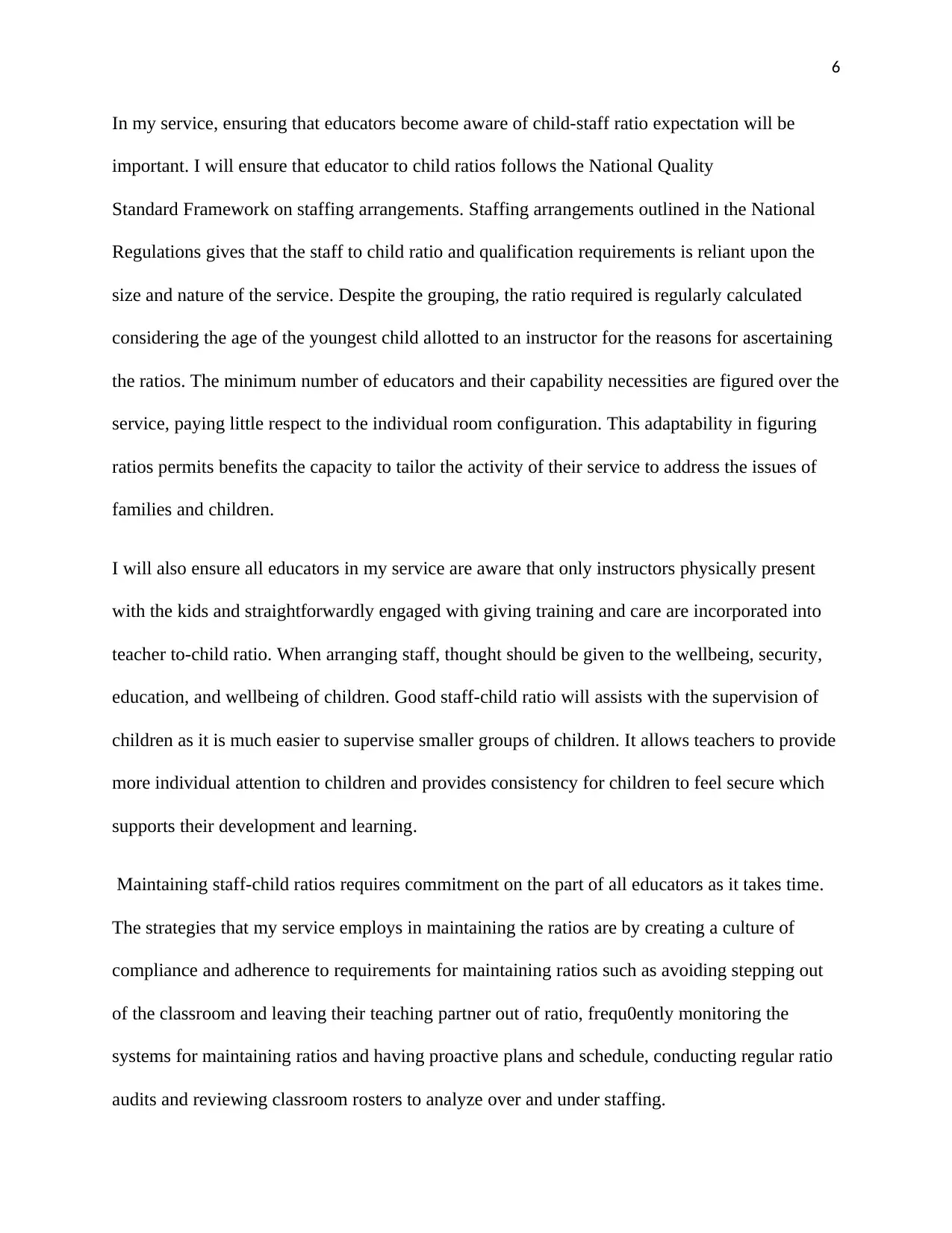
6
In my service, ensuring that educators become aware of child-staff ratio expectation will be
important. I will ensure that educator to child ratios follows the National Quality
Standard Framework on staffing arrangements. Staffing arrangements outlined in the National
Regulations gives that the staff to child ratio and qualification requirements is reliant upon the
size and nature of the service. Despite the grouping, the ratio required is regularly calculated
considering the age of the youngest child allotted to an instructor for the reasons for ascertaining
the ratios. The minimum number of educators and their capability necessities are figured over the
service, paying little respect to the individual room configuration. This adaptability in figuring
ratios permits benefits the capacity to tailor the activity of their service to address the issues of
families and children.
I will also ensure all educators in my service are aware that only instructors physically present
with the kids and straightforwardly engaged with giving training and care are incorporated into
teacher to-child ratio. When arranging staff, thought should be given to the wellbeing, security,
education, and wellbeing of children. Good staff-child ratio will assists with the supervision of
children as it is much easier to supervise smaller groups of children. It allows teachers to provide
more individual attention to children and provides consistency for children to feel secure which
supports their development and learning.
Maintaining staff-child ratios requires commitment on the part of all educators as it takes time.
The strategies that my service employs in maintaining the ratios are by creating a culture of
compliance and adherence to requirements for maintaining ratios such as avoiding stepping out
of the classroom and leaving their teaching partner out of ratio, frequ0ently monitoring the
systems for maintaining ratios and having proactive plans and schedule, conducting regular ratio
audits and reviewing classroom rosters to analyze over and under staffing.
In my service, ensuring that educators become aware of child-staff ratio expectation will be
important. I will ensure that educator to child ratios follows the National Quality
Standard Framework on staffing arrangements. Staffing arrangements outlined in the National
Regulations gives that the staff to child ratio and qualification requirements is reliant upon the
size and nature of the service. Despite the grouping, the ratio required is regularly calculated
considering the age of the youngest child allotted to an instructor for the reasons for ascertaining
the ratios. The minimum number of educators and their capability necessities are figured over the
service, paying little respect to the individual room configuration. This adaptability in figuring
ratios permits benefits the capacity to tailor the activity of their service to address the issues of
families and children.
I will also ensure all educators in my service are aware that only instructors physically present
with the kids and straightforwardly engaged with giving training and care are incorporated into
teacher to-child ratio. When arranging staff, thought should be given to the wellbeing, security,
education, and wellbeing of children. Good staff-child ratio will assists with the supervision of
children as it is much easier to supervise smaller groups of children. It allows teachers to provide
more individual attention to children and provides consistency for children to feel secure which
supports their development and learning.
Maintaining staff-child ratios requires commitment on the part of all educators as it takes time.
The strategies that my service employs in maintaining the ratios are by creating a culture of
compliance and adherence to requirements for maintaining ratios such as avoiding stepping out
of the classroom and leaving their teaching partner out of ratio, frequ0ently monitoring the
systems for maintaining ratios and having proactive plans and schedule, conducting regular ratio
audits and reviewing classroom rosters to analyze over and under staffing.
⊘ This is a preview!⊘
Do you want full access?
Subscribe today to unlock all pages.

Trusted by 1+ million students worldwide
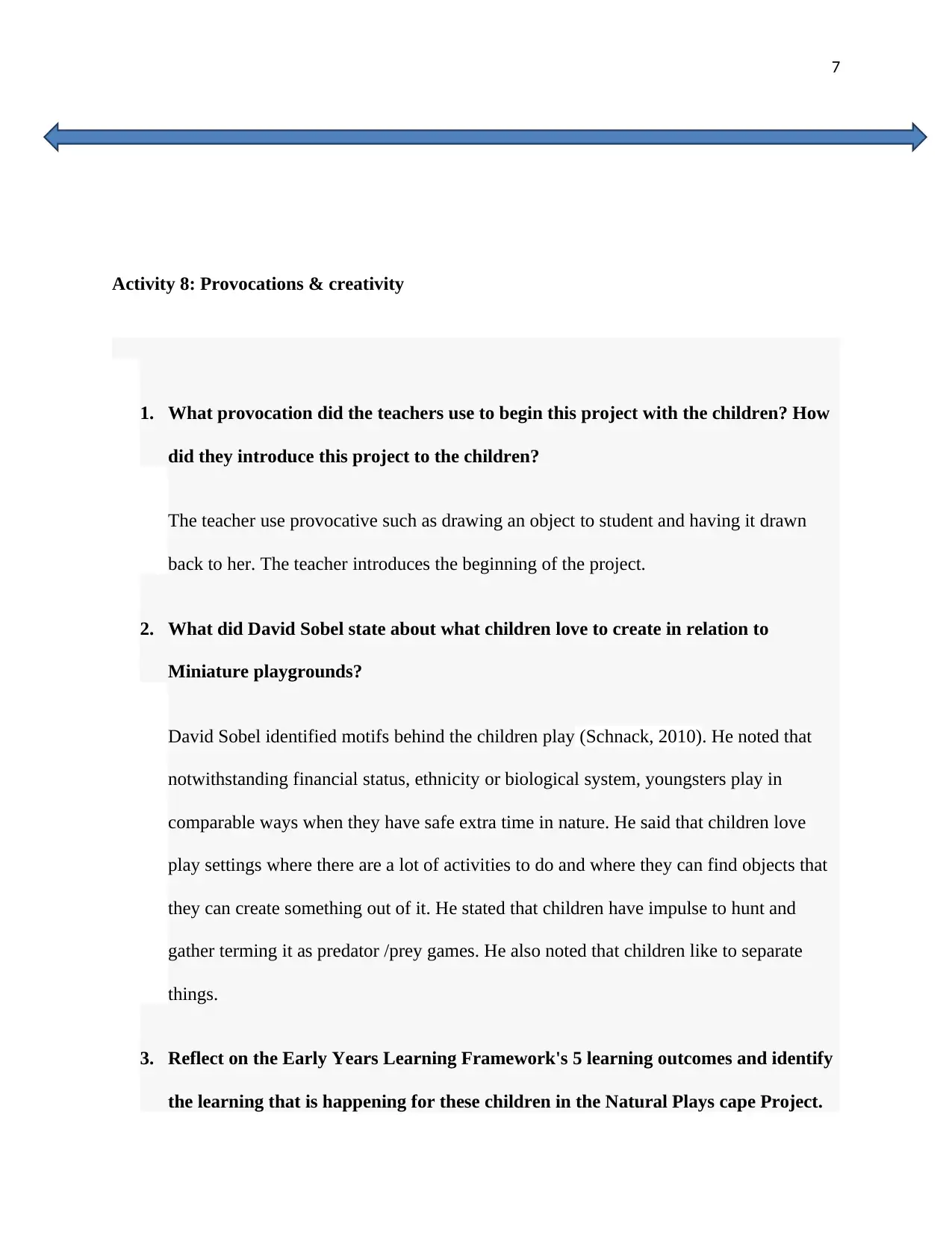
7
Activity 8: Provocations & creativity
1. What provocation did the teachers use to begin this project with the children? How
did they introduce this project to the children?
The teacher use provocative such as drawing an object to student and having it drawn
back to her. The teacher introduces the beginning of the project.
2. What did David Sobel state about what children love to create in relation to
Miniature playgrounds?
David Sobel identified motifs behind the children play (Schnack, 2010). He noted that
notwithstanding financial status, ethnicity or biological system, youngsters play in
comparable ways when they have safe extra time in nature. He said that children love
play settings where there are a lot of activities to do and where they can find objects that
they can create something out of it. He stated that children have impulse to hunt and
gather terming it as predator /prey games. He also noted that children like to separate
things.
3. Reflect on the Early Years Learning Framework's 5 learning outcomes and identify
the learning that is happening for these children in the Natural Plays cape Project.
Activity 8: Provocations & creativity
1. What provocation did the teachers use to begin this project with the children? How
did they introduce this project to the children?
The teacher use provocative such as drawing an object to student and having it drawn
back to her. The teacher introduces the beginning of the project.
2. What did David Sobel state about what children love to create in relation to
Miniature playgrounds?
David Sobel identified motifs behind the children play (Schnack, 2010). He noted that
notwithstanding financial status, ethnicity or biological system, youngsters play in
comparable ways when they have safe extra time in nature. He said that children love
play settings where there are a lot of activities to do and where they can find objects that
they can create something out of it. He stated that children have impulse to hunt and
gather terming it as predator /prey games. He also noted that children like to separate
things.
3. Reflect on the Early Years Learning Framework's 5 learning outcomes and identify
the learning that is happening for these children in the Natural Plays cape Project.
Paraphrase This Document
Need a fresh take? Get an instant paraphrase of this document with our AI Paraphraser
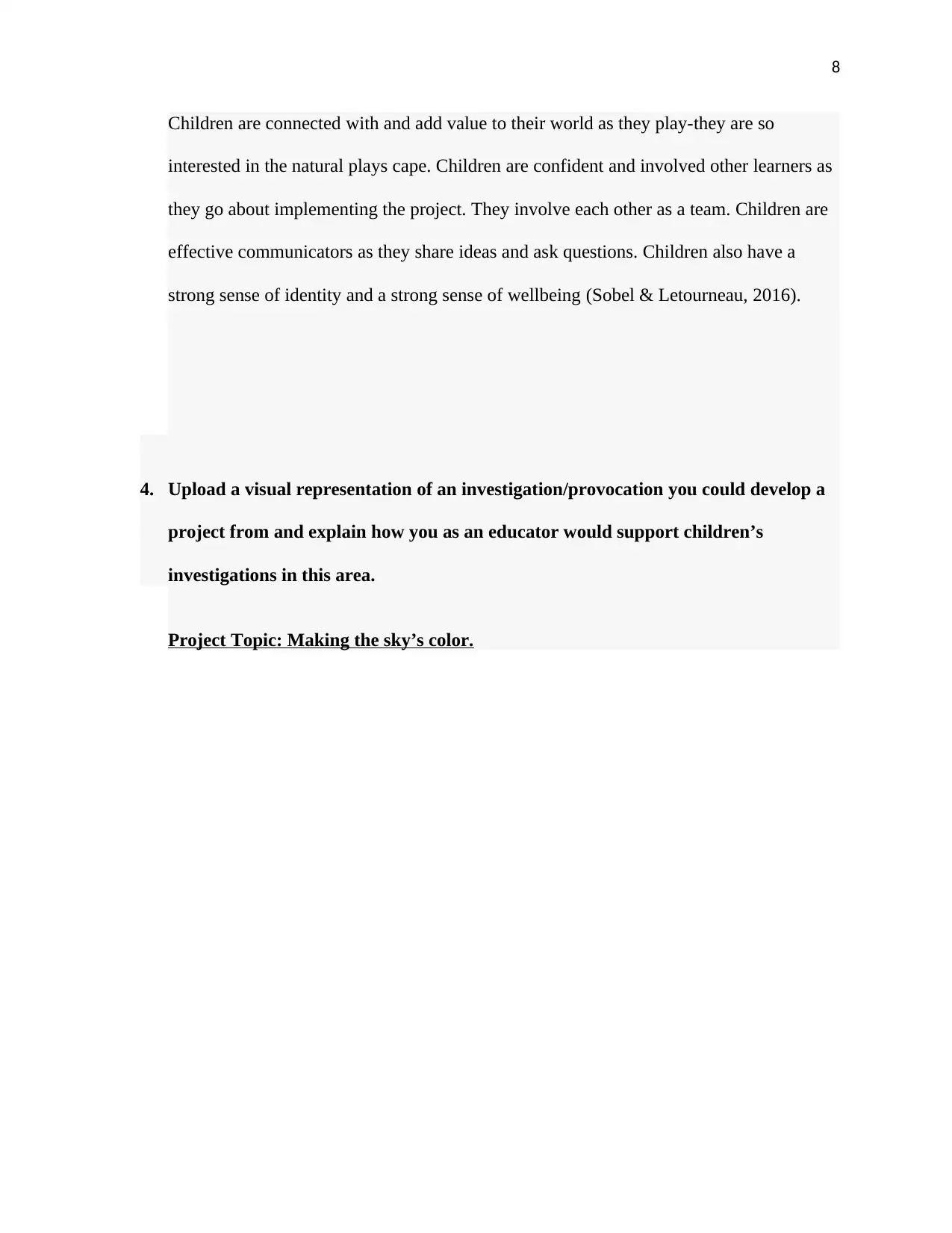
8
Children are connected with and add value to their world as they play-they are so
interested in the natural plays cape. Children are confident and involved other learners as
they go about implementing the project. They involve each other as a team. Children are
effective communicators as they share ideas and ask questions. Children also have a
strong sense of identity and a strong sense of wellbeing (Sobel & Letourneau, 2016).
4. Upload a visual representation of an investigation/provocation you could develop a
project from and explain how you as an educator would support children’s
investigations in this area.
Project Topic: Making the sky’s color.
Children are connected with and add value to their world as they play-they are so
interested in the natural plays cape. Children are confident and involved other learners as
they go about implementing the project. They involve each other as a team. Children are
effective communicators as they share ideas and ask questions. Children also have a
strong sense of identity and a strong sense of wellbeing (Sobel & Letourneau, 2016).
4. Upload a visual representation of an investigation/provocation you could develop a
project from and explain how you as an educator would support children’s
investigations in this area.
Project Topic: Making the sky’s color.
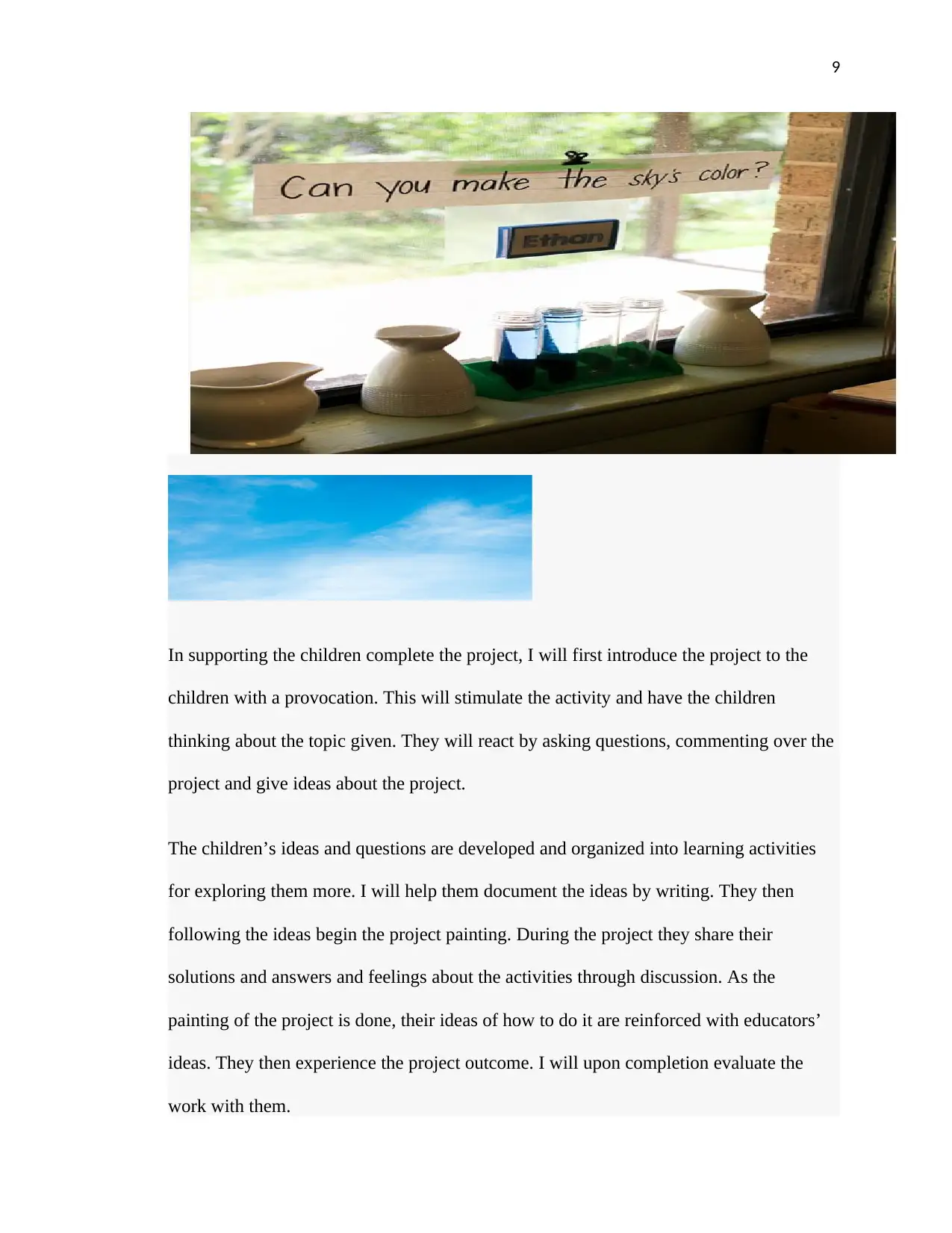
9
In supporting the children complete the project, I will first introduce the project to the
children with a provocation. This will stimulate the activity and have the children
thinking about the topic given. They will react by asking questions, commenting over the
project and give ideas about the project.
The children’s ideas and questions are developed and organized into learning activities
for exploring them more. I will help them document the ideas by writing. They then
following the ideas begin the project painting. During the project they share their
solutions and answers and feelings about the activities through discussion. As the
painting of the project is done, their ideas of how to do it are reinforced with educators’
ideas. They then experience the project outcome. I will upon completion evaluate the
work with them.
In supporting the children complete the project, I will first introduce the project to the
children with a provocation. This will stimulate the activity and have the children
thinking about the topic given. They will react by asking questions, commenting over the
project and give ideas about the project.
The children’s ideas and questions are developed and organized into learning activities
for exploring them more. I will help them document the ideas by writing. They then
following the ideas begin the project painting. During the project they share their
solutions and answers and feelings about the activities through discussion. As the
painting of the project is done, their ideas of how to do it are reinforced with educators’
ideas. They then experience the project outcome. I will upon completion evaluate the
work with them.
⊘ This is a preview!⊘
Do you want full access?
Subscribe today to unlock all pages.

Trusted by 1+ million students worldwide
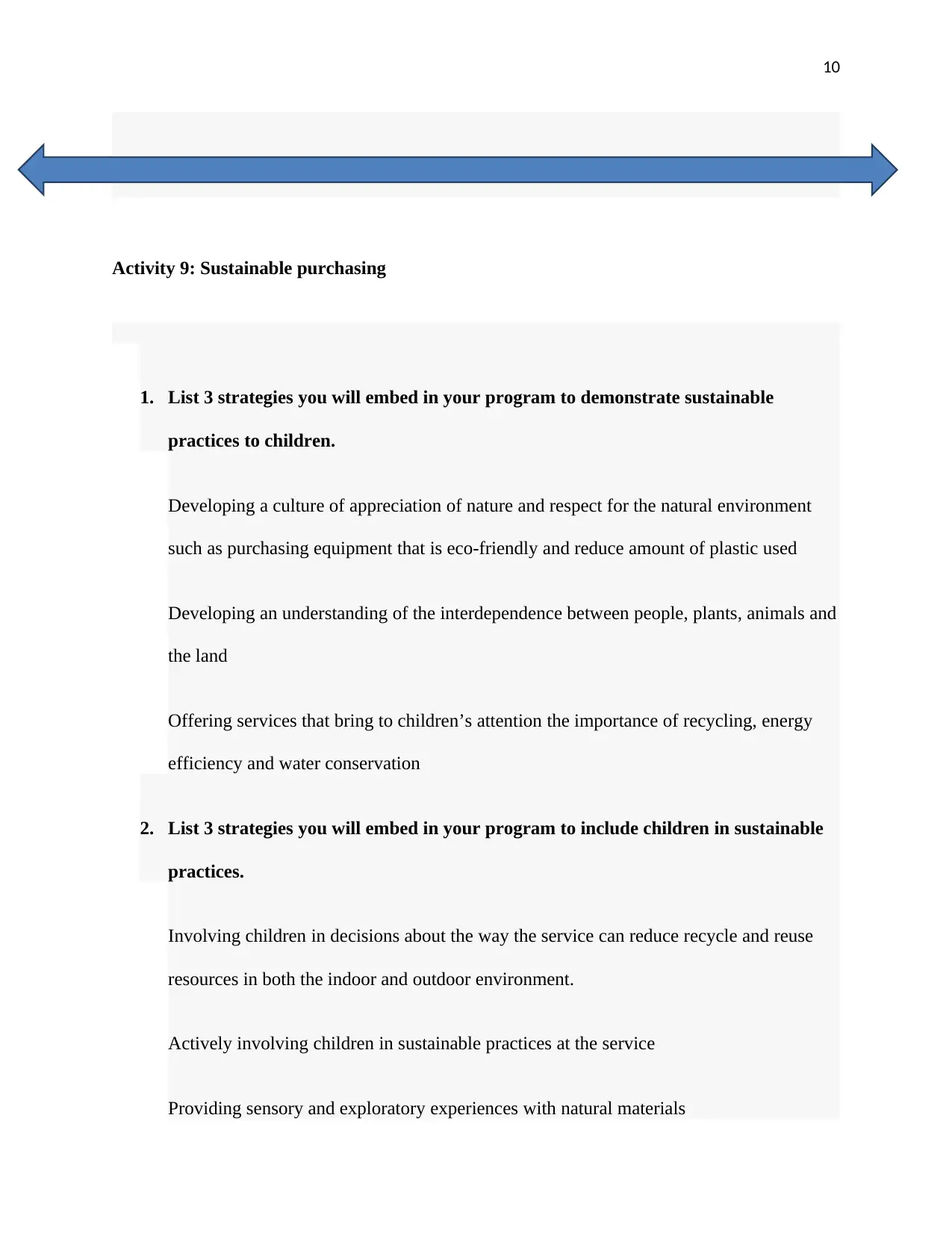
10
Activity 9: Sustainable purchasing
1. List 3 strategies you will embed in your program to demonstrate sustainable
practices to children.
Developing a culture of appreciation of nature and respect for the natural environment
such as purchasing equipment that is eco-friendly and reduce amount of plastic used
Developing an understanding of the interdependence between people, plants, animals and
the land
Offering services that bring to children’s attention the importance of recycling, energy
efficiency and water conservation
2. List 3 strategies you will embed in your program to include children in sustainable
practices.
Involving children in decisions about the way the service can reduce recycle and reuse
resources in both the indoor and outdoor environment.
Actively involving children in sustainable practices at the service
Providing sensory and exploratory experiences with natural materials
Activity 9: Sustainable purchasing
1. List 3 strategies you will embed in your program to demonstrate sustainable
practices to children.
Developing a culture of appreciation of nature and respect for the natural environment
such as purchasing equipment that is eco-friendly and reduce amount of plastic used
Developing an understanding of the interdependence between people, plants, animals and
the land
Offering services that bring to children’s attention the importance of recycling, energy
efficiency and water conservation
2. List 3 strategies you will embed in your program to include children in sustainable
practices.
Involving children in decisions about the way the service can reduce recycle and reuse
resources in both the indoor and outdoor environment.
Actively involving children in sustainable practices at the service
Providing sensory and exploratory experiences with natural materials
Paraphrase This Document
Need a fresh take? Get an instant paraphrase of this document with our AI Paraphraser
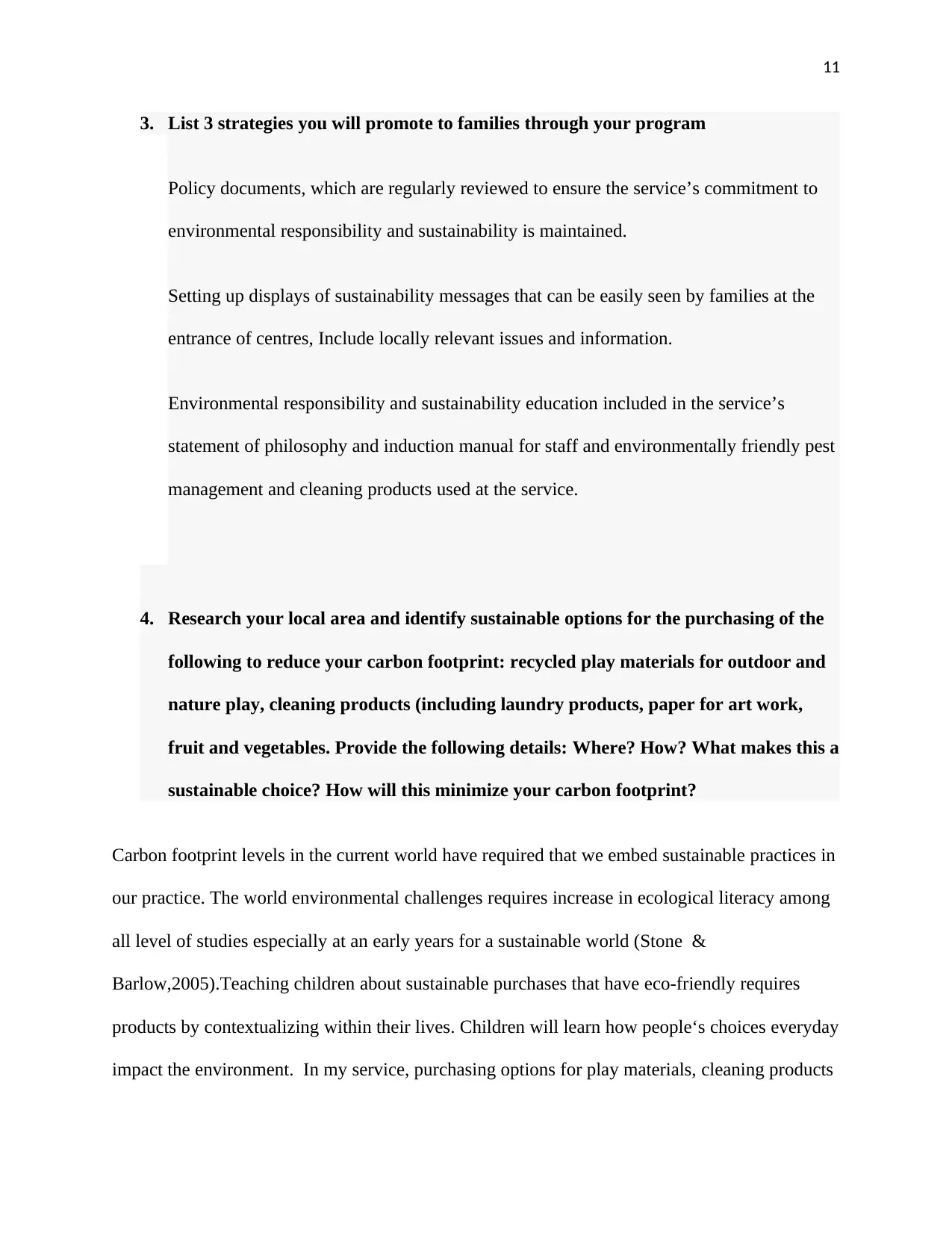
11
3. List 3 strategies you will promote to families through your program
Policy documents, which are regularly reviewed to ensure the service’s commitment to
environmental responsibility and sustainability is maintained.
Setting up displays of sustainability messages that can be easily seen by families at the
entrance of centres, Include locally relevant issues and information.
Environmental responsibility and sustainability education included in the service’s
statement of philosophy and induction manual for staff and environmentally friendly pest
management and cleaning products used at the service.
4. Research your local area and identify sustainable options for the purchasing of the
following to reduce your carbon footprint: recycled play materials for outdoor and
nature play, cleaning products (including laundry products, paper for art work,
fruit and vegetables. Provide the following details: Where? How? What makes this a
sustainable choice? How will this minimize your carbon footprint?
Carbon footprint levels in the current world have required that we embed sustainable practices in
our practice. The world environmental challenges requires increase in ecological literacy among
all level of studies especially at an early years for a sustainable world (Stone &
Barlow,2005).Teaching children about sustainable purchases that have eco-friendly requires
products by contextualizing within their lives. Children will learn how people‘s choices everyday
impact the environment. In my service, purchasing options for play materials, cleaning products
3. List 3 strategies you will promote to families through your program
Policy documents, which are regularly reviewed to ensure the service’s commitment to
environmental responsibility and sustainability is maintained.
Setting up displays of sustainability messages that can be easily seen by families at the
entrance of centres, Include locally relevant issues and information.
Environmental responsibility and sustainability education included in the service’s
statement of philosophy and induction manual for staff and environmentally friendly pest
management and cleaning products used at the service.
4. Research your local area and identify sustainable options for the purchasing of the
following to reduce your carbon footprint: recycled play materials for outdoor and
nature play, cleaning products (including laundry products, paper for art work,
fruit and vegetables. Provide the following details: Where? How? What makes this a
sustainable choice? How will this minimize your carbon footprint?
Carbon footprint levels in the current world have required that we embed sustainable practices in
our practice. The world environmental challenges requires increase in ecological literacy among
all level of studies especially at an early years for a sustainable world (Stone &
Barlow,2005).Teaching children about sustainable purchases that have eco-friendly requires
products by contextualizing within their lives. Children will learn how people‘s choices everyday
impact the environment. In my service, purchasing options for play materials, cleaning products
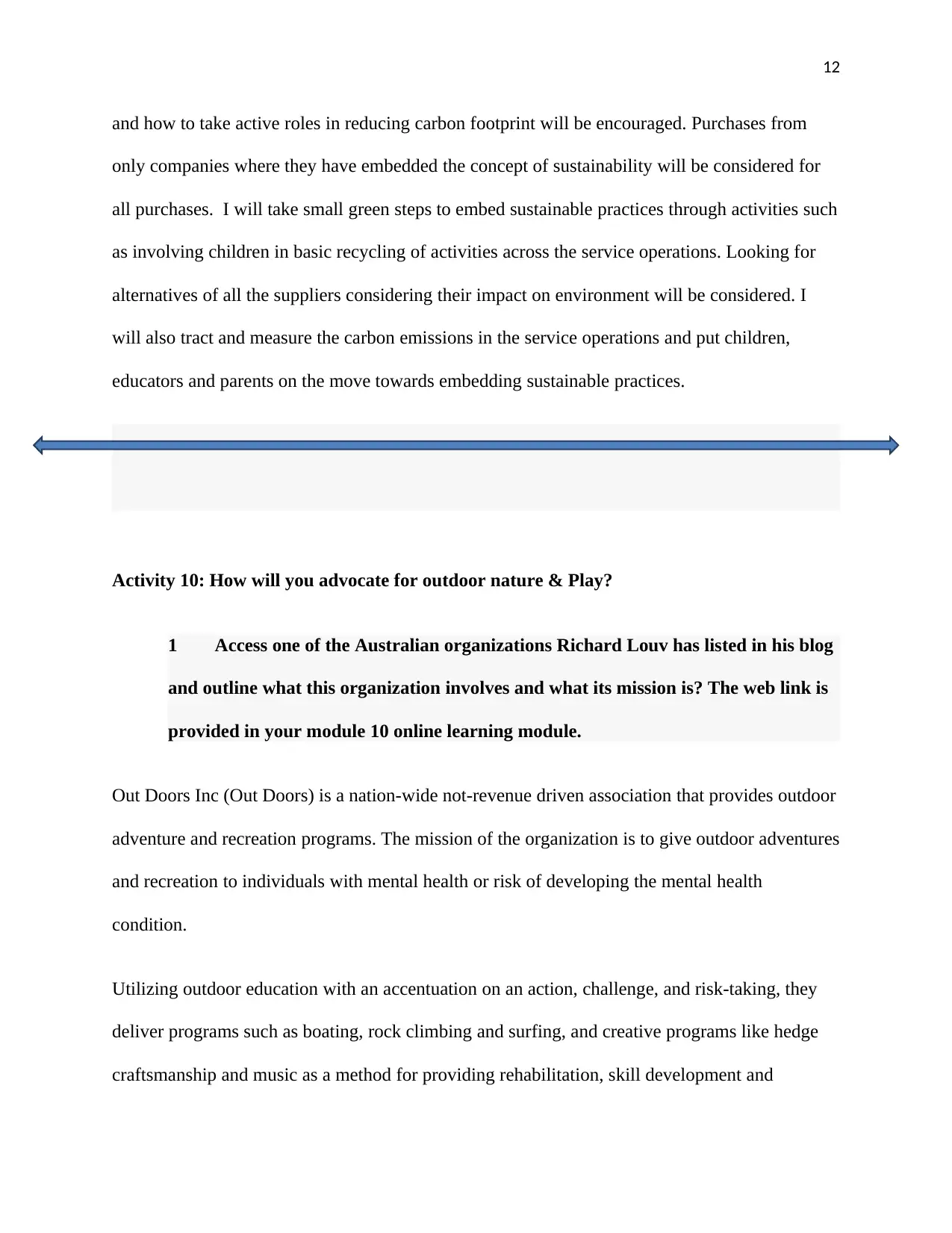
12
and how to take active roles in reducing carbon footprint will be encouraged. Purchases from
only companies where they have embedded the concept of sustainability will be considered for
all purchases. I will take small green steps to embed sustainable practices through activities such
as involving children in basic recycling of activities across the service operations. Looking for
alternatives of all the suppliers considering their impact on environment will be considered. I
will also tract and measure the carbon emissions in the service operations and put children,
educators and parents on the move towards embedding sustainable practices.
Activity 10: How will you advocate for outdoor nature & Play?
1 Access one of the Australian organizations Richard Louv has listed in his blog
and outline what this organization involves and what its mission is? The web link is
provided in your module 10 online learning module.
Out Doors Inc (Out Doors) is a nation-wide not-revenue driven association that provides outdoor
adventure and recreation programs. The mission of the organization is to give outdoor adventures
and recreation to individuals with mental health or risk of developing the mental health
condition.
Utilizing outdoor education with an accentuation on an action, challenge, and risk-taking, they
deliver programs such as boating, rock climbing and surfing, and creative programs like hedge
craftsmanship and music as a method for providing rehabilitation, skill development and
and how to take active roles in reducing carbon footprint will be encouraged. Purchases from
only companies where they have embedded the concept of sustainability will be considered for
all purchases. I will take small green steps to embed sustainable practices through activities such
as involving children in basic recycling of activities across the service operations. Looking for
alternatives of all the suppliers considering their impact on environment will be considered. I
will also tract and measure the carbon emissions in the service operations and put children,
educators and parents on the move towards embedding sustainable practices.
Activity 10: How will you advocate for outdoor nature & Play?
1 Access one of the Australian organizations Richard Louv has listed in his blog
and outline what this organization involves and what its mission is? The web link is
provided in your module 10 online learning module.
Out Doors Inc (Out Doors) is a nation-wide not-revenue driven association that provides outdoor
adventure and recreation programs. The mission of the organization is to give outdoor adventures
and recreation to individuals with mental health or risk of developing the mental health
condition.
Utilizing outdoor education with an accentuation on an action, challenge, and risk-taking, they
deliver programs such as boating, rock climbing and surfing, and creative programs like hedge
craftsmanship and music as a method for providing rehabilitation, skill development and
⊘ This is a preview!⊘
Do you want full access?
Subscribe today to unlock all pages.

Trusted by 1+ million students worldwide
1 out of 18
Related Documents
Your All-in-One AI-Powered Toolkit for Academic Success.
+13062052269
info@desklib.com
Available 24*7 on WhatsApp / Email
![[object Object]](/_next/static/media/star-bottom.7253800d.svg)
Unlock your academic potential
Copyright © 2020–2025 A2Z Services. All Rights Reserved. Developed and managed by ZUCOL.





